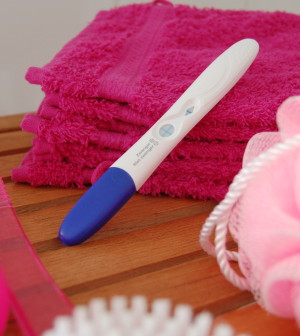- Skip Storing This Everyday Product in the Fridge Door
- Green Tea + B3 Pairing May Boost Brain Health
- Navigating Your Midlife Crisis: Embracing New Possibilities
- City Raccoons Showing Signs of Domestication
- Mapping the Exposome: Science Broadens Focus to Environmental Disease Triggers
- One Week Less on Social Media Linked to Better Mental Health
- Your Brain Changes in Stages as You Age, Study Finds
- Some Suicide Victims Show No Typical Warning Signs, Study Finds
- ByHeart Formula Faces Lawsuits After Babies Sickened With Botulism
- Switch to Vegan Diet Could Cut Your Greenhouse Gas Emissions in Half
Birthing Pool Not the Place to Deliver, New Guidelines Say

While a birthing pool during the early stages of labor may offer some advantages, women should not deliver their baby in the water, new guidelines advise.
Birthing pools can be found in hospitals, birthing centers or at home. A woman in labor lies in a tub of warm water to help ease delivery.
“Immersion in water during the first stage of labor may offer some benefits: It may shorten labor and is associated with a decreased use of epidurals [injecting anesthesia into the spine],” said Dr. Joseph Wax. He chaired the committee that developed the recommendations for the American College of Obstetricians and Gynecologists (ACOG).
“However, it is important to differentiate between laboring in water and delivering in water,” Wax said in an ACOG news release. “There is no evidence to support delivering a baby in water has benefits to the baby.”
In fact, according to the guidelines, delivering a baby in the water may lead to serious health problems. They include: increased risk of mother and infant infections; difficulty in the regulation of the baby’s body temperature; increased chance of umbilical cord damage; respiratory distress resulting from the baby inhaling tub water; and potential for asphyxia (lack of oxygen) and seizures.
Hospitals and birthing centers that offer water immersion for women in the first stage of labor need to follow certain guidelines to protect the health and safety of the mother and baby, ACOG said.
Those measures include: rigorous processes for candidate selection; maintaining and cleaning tubs and immersion pools; following infection control procedures; monitoring pregnant women at appropriate intervals while immersed; and moving women out of the tubs if there are any concerns about the mother or baby.
The recommendations are published in the November issue of the journal Obstetrics & Gynecology.
More information
The U.S. Office on Women’s Health has more about labor and birth.
Source: HealthDay
Copyright © 2025 HealthDay. All rights reserved.










